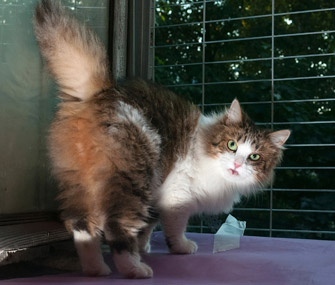Why Does My Cat… Stick Her Butt in My Face?
Published on October 01, 2014
Skip To

Cat Signs Are Subtle
Visual communication is performed via body language. The position of a cat’s ears, head, tail and body all convey a message to other cats and to owners as well. For example, crouching down, flattening the ears and drawing the head toward the shoulders are universal signals that a cat does not want to engage further with other cats — or with you. Direct eye contact, standing tall and piloerection — which is the scientific term for puffing out the fur — are signs that the cat is ready to escalate into an aggressive confrontation.On the other hand, a tail that is held vertically in an upright position while your cat is also calmly gazing and blinking at you is generally associated with friendly behavior. Many times we miss our cat’s subtle body language due to their smaller features compared to dogs. Sometimes the signaling occurs so quickly and the changes are so rapid that we simply don’t see them.
Noise and Noses
Almost everyone has heard cats communicate vocally. Meows, trills, chirps, hisses, yowls and purrs are some of the ways our cats indicate how they are feeling to us as well as other cats. Cats also have various means of olfactory (scent) communication. When we think of cats and marking, we usually think of urine spraying. Yes, cats do mark using their urine, and sometimes feces can be used for marking as well. However, most people overlook the fact that their cats are also marking when they rub parts of their bodies on other cats, humans or objects in the house.Kitties leave a chemical signature when they rub objects with their heads, ears and tails. When cats scratch on items, they can also leave a scent trail through their interdigital glands, which are located between the pads of their paws. Other glands that contribute to marking are located at the corners of the mouth, the sides of the head and under the chin and ears. There are also glands at the base of the tail and along the tail that can deposit odors.
Typically, cats who are friendly toward each other rub their heads, flanks and tails alongside each other. When they perform these behaviors, they are exchanging odors and possibly forming a “colony” scent, which is making sure their odor is familiar to other cats in the group and says “you belong.” (A colony is basically a group of cats who live peaceably together in a home or other setting.) In addition to rubbing, other forms of tactile communication include shared grooming (licking each other) and resting or sleeping next to each other.
Researchers have noted that when one cat approaches a second cat with his tail held up, the first cat is more likely to be rubbed on and sniffed by other colony members. Usually cat-to-cat rubbing occurs after the first cat approaches with his tail up. If the second cat also has his tail in an up position, the probability of being rubbed is increased.
Handshake in Reverse
Why am I telling you all this just to answer the question “Why does my cat stick her behind in my face?”Taking into account some of the information I have shared on the fascinating world of cat communication, many cat owners may be misinterpreting their cats’ posterior presentations. Instead of “sticking her behind in your face,” your cat may very well be asking you for affection or reaffirmation of your social bond by soliciting attention and petting. When you pet your cat, you are also depositing your odors from the glands on your hand and picking up her odors. Cats regard this as being social.
When cats rub alongside each other, they are facing in opposite directions and usually end up standing with their hind ends positioned toward one another. Since we do not rub bodies with our cats but use our hands instead, this is probably why they end up directing their posteriors toward us. I personally see it as a sign that my cat likes me.
And the "bottom line" is just that: Take it as a compliment if your cat gives you the butt.





